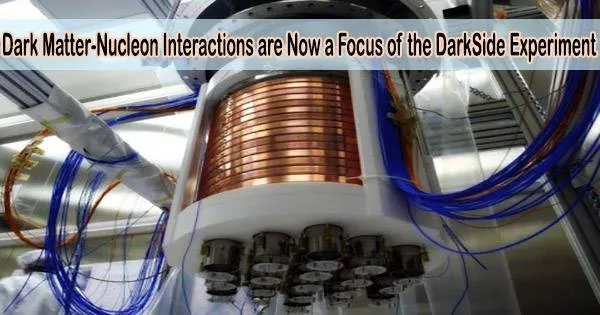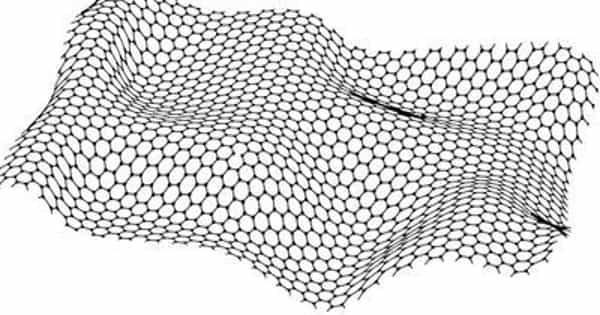The complex DarkSide project uses a dual-phase physics detector at the subterranean Gran Sasso National Laboratory to look for interactions between dark matter particles in liquid argon.
The remarkable discrimination power of the scintillation pulse of liquefied argon in the DarkSide-50 detector, which can distinguish between nuclear recoil events linked to these interactions from more than 100 million electronic recoil events linked to radioactive background, may make it possible to observe these interactions while minimizing background signals.
The detector has recently been put to use by the vast scientific team conducting the DarkSide experiment to look for lighter dark matter particles. They were able to place additional limitations on sub-GeV/c2 dark matter thanks to the findings of a fresh search for dark matter-nucleon interactions, which were reported in Physical Review Letters.
“The DarkSide-50 experiment was designed as a test for the use of argon from underground sources, naturally depleted in the radioactive 39Ar, for very large scale dark matter searches,” Cristiano Galbiati a Researcher at Princeton University and the Gran Sasso Science Institute, told Phys.org.
“It is remarkable to see how a group of young researchers within the collaboration was able to exploit the apparatus to extract the best limit for dark matter searches that were not part of the original scope of the experiment. If anything, the ingenuity and resolve of this group should be credited for this important result.”
According to theoretical projections, interactions involving dark matter are incredibly infrequent, occurring hundreds of times less frequently than those involving radioactive chemicals found in detectors and the environment. Therefore, it is crucial for researchers to be able to suppress these radioactive background signals that can confuse the hunt for dark matter interactions.
The DarkSide experiment specifically searches for dark matter interactions using a noble target, specifically argon liquefied at cryogenic temperatures, at nearly 200 Celsius degrees below zero.
A statistically significant excess of events observed in the detector then becomes a potential dark matter discovery. DarkSide-20k is designed to be most sensitive to standard WIMPs, with masses above 100 GeV/c2. Nonetheless, as for DarkSide-50, we will exploit the ionization channel to perform searches of Light Dark Matter candidates with masses down to tens of MeV/c2.
Claudio Savarese
Because they react to particle interactions by both generating light through a process known as scintillation and releasing charges through ionization, noble liquids are excellent candidates when looking for uncommon physical phenomena.
“Dual-phase time projection chambers are detectors able to measure both the scintillation light and the ionization charges,” Paolo Agnes, a researcher at Gran Sasso Science Institute, told Phys.org. “The bulk of the target mass is in the liquid state. A thin layer of gas is sitting on top of the liquid. The detector is equipped with light detectors, typically sensitive to single photons. By measuring the scintillation light produced in the liquid we can reconstruct the interaction energy.”
By means of an electric field, the ionization electrons inside the DarkSide detector drift towards the surface of the liquid argon. The extraction and subsequent acceleration of these ionization electrons in a gas are made possible by the creation of a greater electric field on the liquid’s surface. For each extracted electron, these accelerated electrons produce a second light burst that typically has hundreds of photons.
“By combining the scintillation and ionization signals, event vertex reconstruction is possible with precision better than 1 cm, allowing for very efficient suppression of some backgrounds, particularly the one coming from the detector surfaces,” Agnes explained.
“A prerogative of liquid argon with respect to other liquids is the very powerful rejection of backgrounds induced by beta and gamma radioactivity, which can be suppressed by nine orders of magnitude by using the shape of the prompt scintillation signal. To further reduce the target intrinsic radioactivity, DarkSide-50 uses a specialized batch of argon, extracted from a CO2 well in Colorado, 1,000 times less radioactive than the argon, commercially available, extracted from the atmosphere.”
The DarksSide-50 detector was operated for five consecutive years at the underground National Laboratory of Gran Sasso in Italy. The information gathered during this time was then examined by researchers that are a part of the DarkSide cooperation to look for dark matter interactions.
The results of the collaboration’s dual-phase liquid argon detector’s first dark matter search conducted without any background noise were reported in 2018. By specifically focusing on argon scintillation, they can search for interactions of WIMPs inducing recoils with energy higher than 40 keV, corresponding to WIMP masses larger than 20 GeV/c2.
Recent improvements in the detector’s potential have enabled the search for much lighter dark matter particles using solely argon ionization. The ionization channel lowers the threshold for the processing of gathered data down to the sub-keV range, albeit it is not as good as the scintillation channel at separating important signals from radioactive background.
“A great effort was devoted to accurately characterize the ionization response to both electronic (background-like) and nuclear (signal-like) recoils, poorly known in such a low energy range,” Davide Franco, a researcher at Laboratoire Astroparticule et Cosmologies CNRS / Paris 7, told Phys.org. “The work done in this direction in 2021 allowed the detector to be calibrated to a few tens of eV], a key element for the recent results. In addition, this work extends the potential of the next generation 50-ton LAr detector (DarkSide-20k) to the detection of core-collapse supernova neutrinos via coherent elastic scattering off nuclei.”
In one of their previous studies, published in Physical Review D in March 2023, DarkSide researchers accurately modeled all background components in excellent agreement with the expected rates from previous detector material screening efforts.
Collectively, these works improved their overall understanding of the detector, offering precious insight that is informing the creation of the DarkSide-20k, an even more advanced detector with a target 1,000 times greater than that of DarkSide-50.
One key novelty of the team’s recent search for dark matter-nucleon interactions is that it was the first to specifically search for nuclear recoils accompanied by the emission of an electronic component (i.e., the Migdal effect) in liquid argon. While the team did not detect meaningful interactions, they were thus able to set new limits on weakly interactive massive particles (WIMPs), bringing them down to a mass of 40 MeV/c2.
“This result broke the generally recognized paradigm of direct dark matter searches, for which the sub-GeV/c2 range is dominated in sensitivity by solid-state technology,” Franco explained. “At the same time, it demonstrated the potential of a few tens of kilograms of liquid argon in such a range, compared with ton-scale liquid xenon detectors. It should not be forgotten among the achievements, those related to the search for interactions of ‘leptophilic’ dark matter particles, i.e., with electron final states.”
As the first direct search for sterile neutrinos interpreted as potential dark matter candidates, the latest work by the DarkSide project marks a significant turning point in the ongoing effort to find WIMPs. Currently, the Global Argon Dark Matter Collaboration is building DarkSide-20K, which will be the most advanced detector to date, set to contain a total target mass of 50 tons of liquid argon.
“We have designed a detector that, for a 100 t yr exposure, should see <0.2 background events (mis-identified electron-recoils (ER) and untagged neutron-induced nuclear recoils (NR)) within the 20.2 t fiducial volume, plus an expected 1.7 ± 0.3 events from the unavoidable physics background of nuclear recoils produced by coherent scattering of atmospheric neutrinos (the ‘atmospheric neutrino fog’),” Claudio Savarese, a researcher at Princeton University, told Phys.org.
“A statistically significant excess of events observed in the detector then becomes a potential dark matter discovery. DarkSide-20k is designed to be most sensitive to standard WIMPs, with masses above 100 GeV/c2. Nonetheless, as for DarkSide-50, we will exploit the ionization channel to perform searches of Light Dark Matter candidates with masses down to tens of MeV/c2.”
Galbiati, Agnes, Franco, Savarese and their colleagues are now evaluating the sensitivity of the DarkSide-20K detector, with the hope that it will allow them to further improve existing constraints on sub-GeV dark matter. Concurrently, they are designing DarkSide-LowMass, a new dedicated experiment that will specifically focus on the search for light dark matter.
“This new apparatus builds on the technological breakthroughs of DarkSide-50 and DarkSide-20k and extends its sensitivity down to the ‘solar neutrino fog,’ meaning that it is so sensitive that neutrinos produced in the solar core become the main detector background,” Savarese said.
“The studies detailing the conceptual design of DS-LM and its reach in the dark matter parameter space have been recently posted on arXiv and are currently being reviewed for publication on Physical Review D.”
The DarkSide-LowMass detector will be a dual-phase time projection chamber containing an active mass of 1.5 tons of argon extracted from underground. This argon is set to undergo an active isotopic purification process, which should reduce by its content of 39Ar by a further factor of 10.
Compared to the DarkSide-50 and DarkSide-20k detectors, DarkSide-LowMass will have an extremely light time projection chamber structure, which is expected to reduce gamma activity due to impurities in the detector materials. A brand-new low-threshold gamma veto system will also be included in order to significantly reduce the remaining background rate.
“Additional studies and technological developments will allow to enhance DS-LM sensitivity to sub-GeV candidates for a second stage of the experiment after the first scientific runs,” Savarese added. “These efforts aim to boost the signal by increasing the amount of charge readout per unit of deposited energy and to lower the detector energy threshold. In essence, the power DS-LM lies in its unrivaled low rate of background events and in its agility to exploit new techniques to boost the DM signal. The road ahead is clear, and I find truly exciting to be able to push the boundaries of science to new lengths.”
















